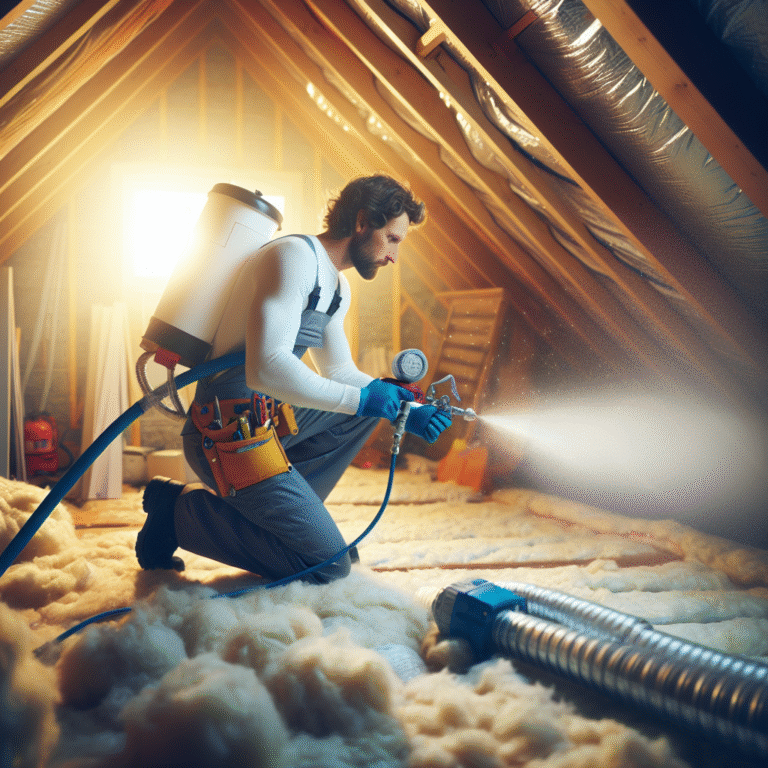-
Table of Contents
Maximize your home’s energy efficiency with the science-backed solution of blown-in insulation.
Discover the science behind blown-in insulation and how it can improve your home’s energy efficiency. Visit texasinsulationsolution.com to learn more and schedule your insulation installation today!”
Introduction
Blown-in insulation is a popular method of insulating homes and buildings, known for its energy efficiency and cost-effectiveness. This type of insulation involves blowing loose fibers or particles into walls, attics, and other spaces to create a barrier against heat transfer. But what is the science behind blown-in insulation and how does it contribute to energy efficiency? In this article, we will explore the principles and mechanisms behind blown-in insulation and its role in promoting energy efficiency in buildings.
The Benefits of Blown-In Insulation for Energy Efficiency in Sugar Land Homes
Blown-in insulation has become a popular choice for homeowners looking to improve the energy efficiency of their homes. This type of insulation involves using a machine to blow loose insulation material, such as fiberglass or cellulose, into the walls, attic, or other areas of a home. This method of insulation has been proven to be highly effective in reducing energy consumption and lowering utility bills. In this article, we will explore the science behind blown-in insulation and how it can benefit homeowners in Sugar Land, Texas.
The primary goal of insulation is to create a barrier between the inside and outside of a home, preventing heat from escaping during the winter and entering during the summer. This is where blown-in insulation excels. The loose material is able to fill in any gaps or voids in the walls or attic, creating a seamless layer of insulation. This is especially beneficial for older homes that may have settled over time, leaving gaps in the walls or attic that can lead to energy loss.
One of the key factors that make blown-in insulation so effective is its ability to reduce air leakage. Air leakage occurs when there are gaps or cracks in a home’s structure that allow air to pass through. This can account for up to 40% of a home’s energy loss. Blown-in insulation fills in these gaps, creating a tight seal that prevents air from escaping. This not only improves energy efficiency but also helps to maintain a consistent temperature throughout the home.
Another important aspect of blown-in insulation is its high R-value. R-value is a measure of an insulation material’s ability to resist heat flow. The higher the R-value, the more effective the insulation is at preventing heat transfer. Blown-in insulation has a higher R-value compared to other types of insulation, making it a more efficient choice for homeowners looking to improve energy efficiency.
In addition to its energy-saving benefits, blown-in insulation also has a positive impact on the environment. The materials used in blown-in insulation, such as fiberglass and cellulose, are made from recycled materials. This reduces the amount of waste in landfills and helps to conserve natural resources. Furthermore, the production process for blown-in insulation has a lower carbon footprint compared to other types of insulation, making it a more environmentally friendly option.
One of the main advantages of blown-in insulation is its versatility. It can be used in various areas of a home, including walls, attics, and crawl spaces. This makes it an ideal choice for both new construction and retrofitting older homes. The installation process is also relatively quick and easy, with minimal disruption to the homeowner. A professional contractor will use a specialized machine to blow the insulation material into the desired area, ensuring a thorough and even coverage.
In conclusion, blown-in insulation offers numerous benefits for homeowners in Sugar Land, Texas, looking to improve the energy efficiency of their homes. Its ability to reduce air leakage, high R-value, and eco-friendly materials make it a top choice for insulation. Additionally, its versatility and ease of installation make it a practical option for both new and existing homes. By investing in blown-in insulation, homeowners can not only save on their energy bills but also contribute to a more sustainable future.
Understanding the Science Behind Blown-In Insulation and How it Improves Energy Efficiency
Blown-in insulation is a popular method of insulating homes and buildings, especially in colder climates. It involves using a machine to blow loose insulation material, such as fiberglass or cellulose, into walls, attics, and other spaces. This method has gained popularity in recent years due to its effectiveness in improving energy efficiency. But what exactly is the science behind blown-in insulation and how does it contribute to energy efficiency? In this article, we will delve into the science behind blown-in insulation and its impact on energy efficiency.
To understand the science behind blown-in insulation, we must first understand how heat moves. Heat always moves from warmer areas to cooler areas, seeking equilibrium. In the winter, heat moves from the inside of a building to the outside, and in the summer, it moves from the outside to the inside. This is known as heat transfer. Insulation works by slowing down this heat transfer, keeping the inside of a building warmer in the winter and cooler in the summer.
Blown-in insulation is particularly effective in slowing down heat transfer because of its unique properties. The loose insulation material is made up of tiny fibers or particles that create air pockets when blown into a space. These air pockets act as a barrier, slowing down the movement of heat. The more air pockets there are, the better the insulation’s ability to resist heat transfer.
One of the key factors that determine the effectiveness of blown-in insulation is its density. The denser the insulation, the more air pockets there are, and the better it can resist heat transfer. This is why blown-in insulation is often preferred over traditional batt insulation, which is typically less dense. The machine used to blow in the insulation allows for precise control over the density, ensuring maximum effectiveness.
Another important aspect of blown-in insulation is its ability to fill in gaps and voids. Traditional batt insulation can leave gaps and spaces, especially in hard-to-reach areas. These gaps can allow for air leakage, reducing the insulation’s effectiveness. Blown-in insulation, on the other hand, can easily fill in these gaps, creating a more airtight barrier. This not only improves energy efficiency but also helps with soundproofing and reducing drafts.
In addition to its insulating properties, blown-in insulation also has other benefits that contribute to energy efficiency. For example, it is made from recycled materials, making it an environmentally friendly option. It also has a longer lifespan compared to other types of insulation, reducing the need for frequent replacements. This not only saves money but also reduces the environmental impact of producing and disposing of insulation materials.
Furthermore, blown-in insulation can also improve indoor air quality. The loose fibers or particles are treated with a fire retardant, which prevents them from settling and becoming airborne. This means that the insulation will not release any harmful particles into the air, making it a safe option for homes and buildings.
In conclusion, the science behind blown-in insulation is based on its ability to create air pockets that slow down heat transfer. Its density, ability to fill in gaps, and other benefits make it a highly effective method of insulation. By reducing heat transfer, blown-in insulation contributes to energy efficiency, resulting in lower energy bills and a more comfortable living or working space. Its environmentally friendly properties and long lifespan make it a sustainable choice for insulation. So, if you are looking to improve the energy efficiency of your home or building, consider blown-in insulation as a viable option.
Maximizing Energy Savings with Professional Blown-In Insulation Services in Sugar Land
Blown-in insulation is a popular method for insulating homes and buildings, especially in areas with extreme weather conditions. It involves using a machine to blow loose insulation material, such as fiberglass or cellulose, into walls, attics, and other spaces. This method has gained popularity due to its effectiveness in maximizing energy savings and improving energy efficiency. In this article, we will delve into the science behind blown-in insulation and how it can help homeowners in Sugar Land save on energy costs.
The primary purpose of insulation is to create a barrier between the inside and outside of a building, preventing heat transfer. Heat transfer occurs in three ways: conduction, convection, and radiation. Conduction is the transfer of heat through solid materials, such as walls and ceilings. Convection is the transfer of heat through air movement, and radiation is the transfer of heat through electromagnetic waves. Insulation works by reducing the amount of heat transfer through these three methods.
Blown-in insulation is particularly effective in reducing heat transfer through convection. The loose insulation material is blown into the walls or attic, filling up any gaps and creating a continuous layer of insulation. This layer acts as a barrier, preventing air from moving in and out of the building. As a result, the temperature inside the building remains constant, reducing the need for heating or cooling systems to work harder, thus saving energy.
Moreover, blown-in insulation is also effective in reducing heat transfer through conduction. The loose insulation material is made up of tiny fibers that trap pockets of air. These pockets of air act as insulators, slowing down the transfer of heat through the material. The more pockets of air there are, the better the insulation. This is why blown-in insulation is considered more effective than traditional insulation methods, such as batts or rolls, which can leave gaps and spaces for air to pass through.
Another advantage of blown-in insulation is its ability to reduce heat transfer through radiation. The insulation material used, such as fiberglass, is a poor conductor of heat. This means that it does not absorb or emit heat easily. As a result, it can prevent heat from escaping or entering a building through radiation. This is particularly beneficial in hot climates, where the sun’s rays can cause a significant amount of heat to enter a building.
In addition to its effectiveness in reducing heat transfer, blown-in insulation also has other benefits that contribute to energy efficiency. For instance, it can improve indoor air quality by reducing the infiltration of outdoor pollutants and allergens. It can also reduce noise levels, making the building more comfortable and peaceful. Furthermore, blown-in insulation is a more eco-friendly option compared to traditional insulation methods. The loose insulation material is often made from recycled materials, reducing the amount of waste that ends up in landfills.
To achieve maximum energy savings and efficiency, it is crucial to hire a professional blown-in insulation service in Sugar Land. These professionals have the expertise and equipment to ensure that the insulation is installed correctly and evenly. They can also help determine the right type and amount of insulation needed for a specific building, taking into consideration factors such as climate, building materials, and energy usage.
In conclusion, blown-in insulation is a scientifically proven method for maximizing energy savings and improving energy efficiency. Its ability to reduce heat transfer through convection, conduction, and radiation makes it a popular choice among homeowners in Sugar Land. With the help of professional blown-in insulation services, homeowners can enjoy a comfortable and energy-efficient living space while also contributing to a greener environment.
Q&A
Q: What is blown-in insulation?
A: Blown-in insulation is a type of insulation material that is installed by blowing it into walls, attics, or other spaces using specialized equipment. It is typically made of small particles of materials such as fiberglass, cellulose, or mineral wool.
Q: How does blown-in insulation improve energy efficiency?
A: Blown-in insulation helps improve energy efficiency by creating a barrier that reduces the transfer of heat between the inside and outside of a building. This helps to keep the interior temperature more consistent, reducing the need for heating and cooling and ultimately lowering energy costs.
Q: What is the science behind blown-in insulation?
A: The science behind blown-in insulation lies in its ability to trap air pockets within the material. These air pockets act as a barrier to heat transfer, preventing warm air from escaping in the winter and cool air from entering in the summer. This helps to maintain a more stable temperature inside the building, reducing the need for energy consumption. Additionally, blown-in insulation is often made of materials with high R-values, which measure the material’s resistance to heat flow. The higher the R-value, the more effective the insulation is at reducing heat transfer.
Conclusion
In conclusion, blown-in insulation is a highly effective method for improving energy efficiency in buildings. Its ability to fill small gaps and crevices in walls and attics helps to prevent heat loss and reduce the workload on heating and cooling systems. The science behind blown-in insulation, specifically its use of trapped air pockets to slow down heat transfer, makes it a cost-effective and environmentally friendly solution for improving energy efficiency. By properly insulating our homes and buildings, we can not only save money on energy bills but also reduce our carbon footprint and contribute to a more sustainable future.




